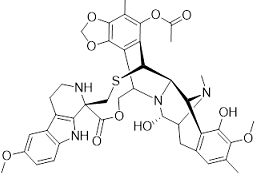All AbMole products are for research use only, cannot be used for human consumption.

Lurbinectedin, also known as PM01183, is a marine-derived covalent DNA binder with potential antineoplastic activity. Lurbinectedin (PM01183) covalently binds to residues lying in the minor groove of DNA, which may result in delayed progression through S phase, cell cycle arrest in the G2/M phase and cell death. Lurbinectedin significantly inhibits tumor growth in a mouse CCC cell xenografts.
| Cell Experiment | |
|---|---|
| Cell lines | CCC cells |
| Preparation method | CCC cells (2×105) were incubated with lurbinectedin at the indicated concentrations for 48 hours. The cells were then fixed with 75% ethanol overnight at -20°C and stained with propidium iodide (PI; 50 μg/mL) in the presence of RNase A (100 μg/mL; Roth) for 60 minutes at 4°C. In each experiment, the cell cycle distribution was determined by analyzing 10,000 cells using a FACScan flow cytometer and Cell Quest software (Becton Dickinson, NJ, USA), as reported previously. |
| Concentrations | - |
| Incubation time | 48 hours |
| Animal Experiment | |
|---|---|
| Animal models | Five- to 7-week-old nude mice injected RMG1 cells |
| Formulation | - |
| Dosages | 0.180 mg/kg |
| Administration | i.v. administered each week for 6 weeks |
| Molecular Weight | 784.87 |
| Formula | C41H44N4O10S |
| CAS Number | 497871-47-3 |
| Solubility (25°C) | DMSO 1 μmol/L |
| Storage |
Powder -20°C 3 years ; 4°C 2 years In solvent -80°C 6 months ; -20°C 1 month |
| Related DNA/RNA Synthesis Products |
|---|
| Deoxyribonucleic Acid (from Salmon sperm)
Deoxyribonucleic Acid (from Salmon sperm) can be used as a research reagent, widely used in molecular biology, pharmacology and other scientific research. |
| GSK4418959
GSK4418959 (IDE275) is a non-covalent, reversible, selective and orally active WRN helicase inhibitor. GSK4418959 inhibits ATPase and DNA unwinding functions in an ATP-competitive manner. |
| Dencatistat
Dencatistat (P115) is an inhibitor of Cytidine Triphosphate Synthase 1 (CTPS1) with an IC50 value of ≤ 0.1 μM. |
| Antipain dihydrochloride
Antipain dihydrochloride is a protease inhibitor. Antipain dihydrochloride inhibits N-methyl-N'-nitro-N-nitrosoguanidine (MNNG)-induced transformation and increases chromosomal aberrations. Antipain dihydrochloride also restricts uterine DNA synthesis and function in mice. |
| Tetrahydrouridine
Tetrahydrouridine (THU) is potent inhibitor of cytidine deaminase (CDA), which competitively blocks the enzyme's active site more effectively than intrinsic cytidine. |
All AbMole products are for research use only, cannot be used for human consumption or veterinary use. We do not provide products or services to individuals. Please comply with the intended use and do not use AbMole products for any other purpose.


Products are for research use only. Not for human use. We do not sell to patients.
© Copyright 2010-2024 AbMole BioScience. All Rights Reserved.
